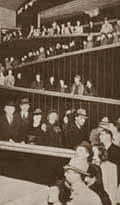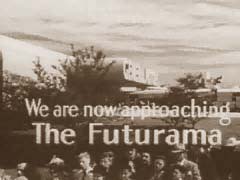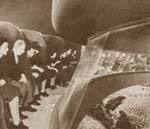 [6]
The 1939 World's Fair, held on the cleaned-up site of a former
ash-dump in Flushing Meadows, New York, set the stage for a powerful
vision of the future. Industrial designer Norman Bel Geddes' model
America of 1960 was an immense diorama stretching over 35,000
square feet; it was housed in the impressively modern General
Motors Pavilion. The "Futurama ride" was the highlight of the
Fair, attracting up to 28,000 people a day over the two-year duration
of the fair (Corn, 49). According to the accompanying tour guide,
the model consisted of "a half-million buildings and houses --
thousands of miles of multi-lane highways -- more than a million
trees -- rivers, lakes and streams -- snow-capped mountains -- rich-flowering
countryside -- industrial centers -- college and resort towns --
great, towering cities" ("Futurama," 24). Visitors were seated
in a "carry-go-round" consisting of 552 plush chairs, which moved
slowly around the sides of the diorama as simulated night fell
and the sun rose again. The tour was narrated by a voice issuing
from a sound-box in each chair.
[6]
The 1939 World's Fair, held on the cleaned-up site of a former
ash-dump in Flushing Meadows, New York, set the stage for a powerful
vision of the future. Industrial designer Norman Bel Geddes' model
America of 1960 was an immense diorama stretching over 35,000
square feet; it was housed in the impressively modern General
Motors Pavilion. The "Futurama ride" was the highlight of the
Fair, attracting up to 28,000 people a day over the two-year duration
of the fair (Corn, 49). According to the accompanying tour guide,
the model consisted of "a half-million buildings and houses --
thousands of miles of multi-lane highways -- more than a million
trees -- rivers, lakes and streams -- snow-capped mountains -- rich-flowering
countryside -- industrial centers -- college and resort towns --
great, towering cities" ("Futurama," 24). Visitors were seated
in a "carry-go-round" consisting of 552 plush chairs, which moved
slowly around the sides of the diorama as simulated night fell
and the sun rose again. The tour was narrated by a voice issuing
from a sound-box in each chair.
[7] Futurama was a part of a larger exhibition offered by General Motors
called "Highways and Horizons." Its purpose was twofold: to offer
a model of improved highways of the future (thereby clinching the
sale of more cars), and to spike consumer confidence more broadly
in goods, cars and appliances of the future. The issue of America's
reluctance to be involved in the rapidly escalating war in Europe
was temporarily quashed by visions of a grand, utopian future of spectacular
superhighways, ironically borrowed from Hitler's Reichsautobahnen
(begun in 1933).
 [8]
To help sell its dream of a mechano-utopian future, General Motors
enlisted the popular modern narrative of progress, arguing that "history
shows that the progress of civilization has run parallel to advancement
in transportation" ("Futurama," 2). Even the General Motors Pavilion
itself, a white deco-curved giant of a building, featured superhighway-inspired
ramps to allow public entrance. Superhighways, thus, were seen as
a symbol of progress, in this case imagined as a road leading into
a bright, utopian future.
[8]
To help sell its dream of a mechano-utopian future, General Motors
enlisted the popular modern narrative of progress, arguing that "history
shows that the progress of civilization has run parallel to advancement
in transportation" ("Futurama," 2). Even the General Motors Pavilion
itself, a white deco-curved giant of a building, featured superhighway-inspired
ramps to allow public entrance. Superhighways, thus, were seen as
a symbol of progress, in this case imagined as a road leading into
a bright, utopian future.

 [6]
The 1939 World's Fair, held on the cleaned-up site of a former
ash-dump in Flushing Meadows, New York, set the stage for a powerful
vision of the future. Industrial designer Norman Bel Geddes' model
America of 1960 was an immense diorama stretching over 35,000
square feet; it was housed in the impressively modern General
Motors Pavilion. The "Futurama ride" was the highlight of the
Fair, attracting up to 28,000 people a day over the two-year duration
of the fair (Corn, 49). According to the accompanying tour guide,
the model consisted of "a half-million buildings and houses --
thousands of miles of multi-lane highways -- more than a million
trees -- rivers, lakes and streams -- snow-capped mountains -- rich-flowering
countryside -- industrial centers -- college and resort towns --
great, towering cities" ("Futurama," 24). Visitors were seated
in a "carry-go-round" consisting of 552 plush chairs, which moved
slowly around the sides of the diorama as simulated night fell
and the sun rose again. The tour was narrated by a voice issuing
from a sound-box in each chair.
[6]
The 1939 World's Fair, held on the cleaned-up site of a former
ash-dump in Flushing Meadows, New York, set the stage for a powerful
vision of the future. Industrial designer Norman Bel Geddes' model
America of 1960 was an immense diorama stretching over 35,000
square feet; it was housed in the impressively modern General
Motors Pavilion. The "Futurama ride" was the highlight of the
Fair, attracting up to 28,000 people a day over the two-year duration
of the fair (Corn, 49). According to the accompanying tour guide,
the model consisted of "a half-million buildings and houses --
thousands of miles of multi-lane highways -- more than a million
trees -- rivers, lakes and streams -- snow-capped mountains -- rich-flowering
countryside -- industrial centers -- college and resort towns --
great, towering cities" ("Futurama," 24). Visitors were seated
in a "carry-go-round" consisting of 552 plush chairs, which moved
slowly around the sides of the diorama as simulated night fell
and the sun rose again. The tour was narrated by a voice issuing
from a sound-box in each chair.  [8]
To help sell its dream of a mechano-utopian future, General Motors
enlisted the popular modern narrative of progress, arguing that "history
shows that the progress of civilization has run parallel to advancement
in transportation" ("Futurama," 2). Even the General Motors Pavilion
itself, a white deco-curved giant of a building, featured superhighway-inspired
ramps to allow public entrance. Superhighways, thus, were seen as
a symbol of progress, in this case imagined as a road leading into
a bright, utopian future.
[8]
To help sell its dream of a mechano-utopian future, General Motors
enlisted the popular modern narrative of progress, arguing that "history
shows that the progress of civilization has run parallel to advancement
in transportation" ("Futurama," 2). Even the General Motors Pavilion
itself, a white deco-curved giant of a building, featured superhighway-inspired
ramps to allow public entrance. Superhighways, thus, were seen as
a symbol of progress, in this case imagined as a road leading into
a bright, utopian future.